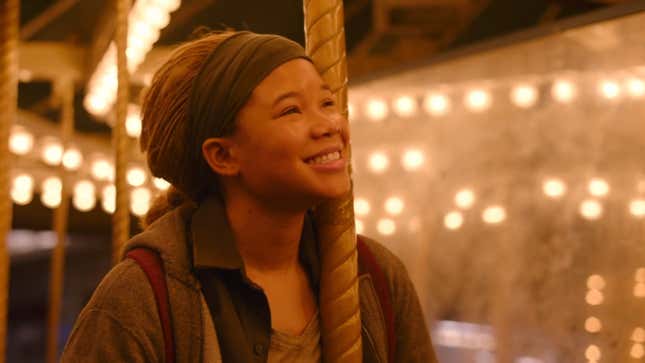
The Last of Us’ TV adaptation is a rare bird in terms of staying true to its source material—particularly when it comes to video games. But even a show that aims to be as authentic as HBO’s treatment of the hit PlayStation series needs to make a few changes to adapt to a different form of storytelling. After the premiere of the show’s second episode, “Infected,” we now know a little bit more about how the infection spread, as well as where it likely came from. Expect this blog to receive future updates as the show continues.
The Last of Us tells a story of post-apocalyptic survival in the wake of a catastrophic pandemic that permanently changes the world as we know it. In The Last of Us’ take on science fiction, the zombie apocalypse is brought on by a mutated form of a very real fungal infection. The show keeps this premise, but makes a few key changes that affect the lore and storytelling. But that’s not the only change the show makes. In-world events, infection specifics, character relationships, and more are all gently tweaked with this live-action trip through a post-apocalyptic America. It should go without saying, but what follows contains spoilers for The Last of Us in TV and game form.
Update 01/31/22: Episode three didn’t just bring us all to tears with Bill and Frank’s story, it introduced a few other notable alterations to the world.
Update 02/23/23: This blog has been updated to reflect lore changes up to episode six of The Last of Us.
Update 03/07/2023: This blog has been updated to reflect significant lore changes up to episode eight The Last of Us.

Embellishment: Riley and the Fireflies
Despite the change in what video game Ellie and Riley happen to enjoy (which we discussed here a few weeks ago), much of HBO’s adaptation of The Last of Us’ story DLC hews very close to what we saw in the game. In it, we flash back to see Ellie’s friend Riley, who has now joined the Fireflies. Remember them? They’re the militia group interested in exploring a cure based on Ellie’s immunity.
During the episode we get a look at where Riley’s been sleeping: hanging out in an old abandoned mall. In this makeshift bedroom, Ellie discovers Riley has been spending her time hunting a book Ellie is fond of….and making pipe bombs. Ya know, average teenage girl stuff.
In the video game we learned that Riley has joined the Fireflies, but don’t have much sense of what they have her do aside from an abbreviated conversation in which she reveals that she had to kill an infected to prove herself. In the TV show, Riley is building pipe bombs that are, presumably, to be used on FEDRA targets. Ellie determines that Riley is actually stationed at the mall, basically preparing for attacks on FEDRA. And it’s implied that such actions from the Fireflies also result in collateral damage and loss of life that’s not intended but, oops, probably happens more often than not.
This is significant to note because of how this frames the Fireflies. In the game and the show, Joel expresses skepticism about their cause, beliefs, and actions, and maybe now we know why.
There’s another key beat, one that shines a light on FEDRA as well. Riley tells Ellie that she more or less had to leave and join the Fireflies because of the fascistic nature of FEDRA. While it’s certainly hard to deny that FEDRA rules with a heavy hand, what brutally oppressive request did FEDRA make of her? Well, let Riley spell that out for you:
I turn 17 next month. That’s when you get your assignment [from FEDRA]. You know what Kwong gave me? Sewage detail. Standing guard while people shovel shit. That’s what they think of me.
So yeah, Riley doesn’t want to shovel shit. But that task, though unenviable, is kind of important for society to function, you know? While there’s often reason to believe that FEDRA isn’t great with the power it wields, if that’s the only reason Riley has for turning against the organization, it sounds a little thin, doesn’t it? Certainly not on the level of war crimes or even the surveillance state we heard was deployed in Kansas City in episode five.
Episode seven paints the Fireflies as an organization willing to exploit a young woman’s frustration by promising her a heroic future, giving her a gun, and asking her to build bombs to use against the evil “fascist dickbags” who, uh, need to make sure that sewage gets taken care of.
You’ll want to meditate on that little fact about the Fireflies after next week’s finale.
Change: Kansas City instead of Pittsburgh
Episode three made some dramatic changes to Bill and Frank’s story, but it was still a revision of existing characters in the original game. Episode four, however, changes Joel and Ellie’s journey quite a bit more. Instead of stopping at Pittsburgh, the duo end up in Kansas City, Missouri (or as someone I once knew used to say: Kansas City, Misery).
While many details are similar (Joel and Ellie still crash in a pickup truck after being ambushed, resulting in a tense shootout between Joel and hostile human forces), this swap of location alters the details of the duo’s journey while providing the opportunity for a new story: that of Kathleen and the Kansas City Militia.
Addition and Change: Kathleen and the Kansas City Militia
HBO’s The Last of Us introduces us to Kathleen and Perry, key figures in an uprising against FEDRA in Kansas City. The politics of the whole situation are…complicated, to say the least. What we do know, however, is that Kathleen is a lady on a warpath (relatable), who’s driven to find another character we’ll talk about in just a second.
This episode marks another addition to the existing lore of the game. Across episodes four and five we learn that FEDRA ran a pretty tight, fascistic state in the KC QZ. This inspired enough resentment that folks were ready to take up arms and overthrow it…proceeding to sort out and kill all who had previously collaborated with FEDRA. But there’s also a notable change: The show gives names and faces to the previously nameless waves of hostile, uninfected humans you had to kill in the game. The game only referred to these folks as “Hunters,” which was one of the factions you could play as in the original’s multiplayer (which is still up and running in 2014’s PS4 remaster, by the way).
While the game gives a bit of background lore to the Hunters, they’re mostly just in-game opposition for you to shoot and hurl bricks at. HBO’s show takes the opportunity to give them a bit more nuance, history, and backstory, much as The Last of Us: Part II did with its antagonists.
Same: Savage Starlight
While fictional arcade game The Turning was tossed perhaps in favor of the more audience-recognizable Mortal Kombat II, it’s great to see that the in-world comic series Savage Starlight didn’t end up on Craig Mazin’s cutting room floor.
A comic series from the world now lost, Ellie grows quite fond of the series and, just as in the game, is quick to quote its signature line: “Endure and Survive.”
Changes: Henry and Sam
Henry and Sam make another powerful appearance this episode, with memorable and harrowing performances from Lamar Johnson and Keivonn Woodard. Seriously, I can’t get their final scene out of my head. Check out Kotaku’s exclusive interview with Lamar Johnson here:
The two brothers do appear in the original game and are an essential part of the story, but the show makes some notable changes. HBO’s Joel and Ellie encounter Henry and Sam in Kansas City, not Pittsburgh. And in the game, Joel and Ellie just sort of discover these two as another pair of survivors. HBO’s adaptation, however, gives them a bit more backstory and makes Henry and Sam locals of Kansas City. Locals, and wanted.
In the show we learn that Henry had to work as a collaborator with FEDRA during its reign to secure necessary medicine for his brother, Sam, who had leukemia. Sam is also deaf in the HBO adaptation, and communicates with Henry via ASL.
While many of the story beats still match, especially Henry and Sam’s tragic deaths, HBO weaves them into a new narrative that adds more depth and nuance than the game offered.
Addition and Change: Marlon and Florence
After the shocking events of episode five, HBO’s show flashes forward a number of months into the winter, when Ellie and Joel encounter another couple living out their days in a comfortably secluded location: Marlon and Florence.
Their addition to the lore is notable as they are new characters, represent a new stopping point for Joel and Ellie, and also cast the world in a different light, much as the changes to Bill and Frank did.
So much of the game’s portrayal of this world is focused on its fallen state. It’s what made Bill and Frank’s revision so notable in the show: Seeing people, particularly those of marginalized identities, enjoying lives of prosperity and safety is a change to the lore as well as the overall tone of The Last of Us, and I am absolutely here for it. While we don’t spend as much time with Marlon and Florence as we do with Bill and Frank, their quality of life represents a level of comfort and happiness the games were never keen on revealing.
Same/Change: Joel’s Interrogation Techniques
I almost missed this one, but when Joel and Ellie come across Marlon and Florence in the cabin, Joel points to a spot on a map, asks for a specific location, and says “Your answer better be the same as your wife’s.” If you’ve played The Last of Us Part I or Part II then you’ll remember this as an interrogation technique Ellie would come to learn from Joel (video contains spoilers for The Last of Us and Part II):
Something of note here, in terms of the adaptive process of turning the game into a show, is that the scene with Marlon and Florence never happens in the game. But the map interrogation trick is a part of both games’ storytelling, especially in the sequel. In adding new characters and embellishments to the existing narrative, HBO’s adaptation of the show is also doubling down on key themes and elements of its characters.
That said, there is an important change here. In the game, Joel brutally beats and stabs two individuals before holding up the map. It’s cold, calculating, and ruthless. While the show does later on discuss Joel’s violent history in the 20 years he’s had to survive, the “interrogation” of Marlon and Florence has a comedic flair, in that Joel is matched in wits with Marlon. Though it might not be a core change to Joel’s character, the lack of viciousness is a dramatic shift in tone from what we first saw in the 2013 game.
It’s Complicated: Joel’s mental state and panic attacks
This is a tricky one. In episode six we see Joel’s instantly memeable panic attacks start to kick in. When we consider that it was never a secret that Joel was likely a mess upstairs in the game, it might be hard to call this a change, but rather an embellishment. That said, we never see this kind of behavior in video game Joel.
So that’s a key change, right? Well, not so fast.
As it turns out, TV Joel’s anxiety issues might not be exclusive to the show as of 2022. In Part I, the recent remake of the first game, the player can spot anti-anxiety medication on Joel’s nightstand prior to the outbreak. While the original 2013 game (and remaster) does have a pill bottle on the same nightstand, it’s impossible to make out what it is—and what little we can see makes it look a little bit more like a multivitamin bottle or even something like melatonin, with hints of colorful artwork that don’t typically appear on essential medication. (From personal experience, I can tell you that neither melatonin nor multivitamins will help with anxiety.)
Given how much the dude has been through, I would hesitate to completely say Joel’s anxiety doesn’t exist in the original game (one would have to ask Neil Druckmann and Bruce Straley what that bottle was supposed to contain in 2013). And, when you consider that the remake has sort of canonized this aspect of Joel’s health, it does reflect an actual change to the game, not just its parallel-universe show. As I had said previously about this little addition, it makes me wonder if there’s more to that remake than we initially thought. (Great. Another reason to play this friggin’ game again.)
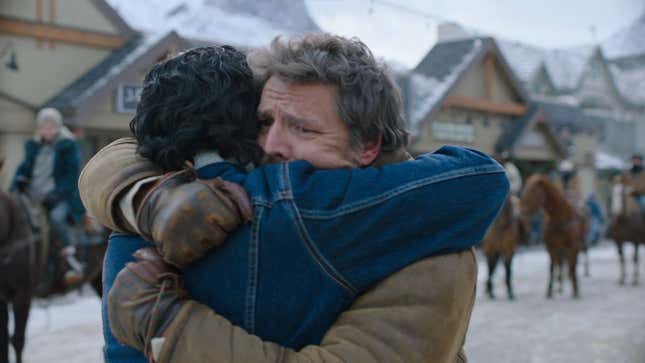
Changes: Joel and Tommy reunite
We learn early on that Joel and Tommy become separated after the outbreak. Tommy goes off trying to join the rebellious Fireflies and loses touch with Joel. In the game, Joel and Tommy reunite at a dam where Tommy is attempting to restore power to the settlement of Jackson, Wyoming.
In the show, Joel and Ellie end up directly in Jackson (which we don’t really see to any serious degree until the game’s sequel). It’s here that the brothers’ tearful reunion happens.
Without the threat of hostile forces, the peaceful commune of Jackson provides a space for Joel and Tommy to reconnect and discuss the situation with Ellie.
And as spotted on Reddit, there’s an interesting flip of a line of a dialogue from the game (which is yet another mirror image twist that seems to be very common in this adaptation). When the Miller brothers depart, video game Joel says “Adios, little brother,” while the show has Tommy say “Adios, big brother.”
Change: Mortal Kombat II replaces The Turning
Early on in episode three of The Last of Us, Joel and Ellie look for supplies in one of the rare instances of an actual TLoU game mechanic represented in the show. As Joel looks through an old shop for supplies, Ellie catches sight of an old and crumbling Mortal Kombat II arcade cabinet and gushes over how cool Mileena is. In the game, however, these specifics were a little different.
Read More: The Last of Us Show Might Be Better If It Worked More Like The Game
In the game’s very similar sequence, an arcade cabinet catches Ellie’s eye, but it’s not Mortal Kombat. Instead, it’s a fictional fighting game called The Turning, and the character that Ellie’s obsessed with is called “Angel Knives.”
It’s a minor change for sure, but I have to admit that I’m a sucker for in-world fictional media like The Turning; so it’s a tiny bummer to see some of The Last of Us’ original world building tossed in the adaptation.
Same: The government sucks (and struggles to stay in power)
Episode three of The Last of Us gives us a look at just how badly its American government handled the outbreak. As Ellie and Joel make their way to Bill and Frank’s, the two stop by the site of a mass grave, where U.S. soldiers executed perfectly healthy people as that seemed an easier alternative than doing the work of providing safety and shelter. A fictional concept, I’m sure.
This parallels the opening of The Last of Us game, in which a soldier opens fire under orders to do so at Joel and Sarah.
And a quick line of dialogue from TV Frank reveals some additional parallels to the game. As Frank explains to Bill why he’s heading for the Boston quarantine zone, he states that the Baltimore QZ is “gone.” Like quarantine zones in the video game (with The Last of Us Part II showing this pretty clearly), QZs seem particularly prone to collapse as FEDRA struggles to get a hold of infection rates and rising militia groups.
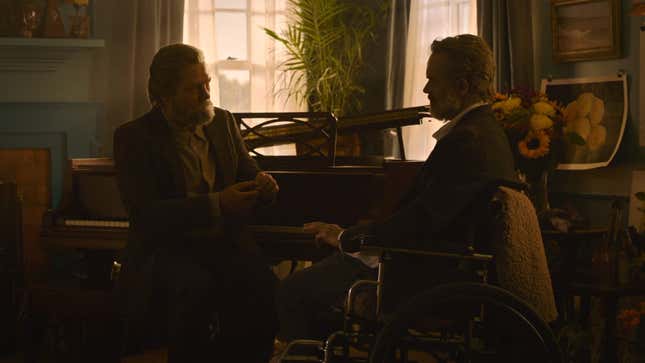
Change: Bill and Frank’s entire arc
I’m not crying; you’re crying!
In the video game, Bill also lives in a town by himself, protected by various traps he’s set up to keep assholes and infected at bay. He also has a partner named Frank…but all we see of him in the game is what’s left of him after he takes his own life following a bite from an infected. He leaves a not-so-great note behind essentially telling Bill off. In the game, Bill provides a pickup truck to Ellie and Joel, and then we don’t really see any more of him after that chapter.
HBO’s The Last of Us doesn’t just tweak this sequence of events, it makes a radical departure in one of the best episodes of television I’ve seen in recent memory. Bill and Frank’s relationship becomes a deeply poignant story of two queer people who have found each other at the end of the world and manage to experience love and companionship for the remainder of their lives.
Read More: HBO’s The Last of Us Reclaims The Queerness Its World Forgot
Most of the episode chronicles Bill and Frank’s life together, starting with some added background for how Bill managed to survive the pandemic. Considering the context of starting the show in 2003, and Bill’s…interesting politics indicated by a “Don’t Tread On Me” flag, it’s hard to imagine that two queer people would’ve been able to live such an open and honest life in the midwest of the United States the way Bill and Frank were if the government and social order didn’t fall apart.
Episode three has proven that not only can an adaptation of a video game work exceedingly well when the source material is respected, but that there’s also room for deviations, especially when it adds so much more to existing characters.
Change: The origin of Ellie’s iconic shirt
When we meet Ellie in the video game, she’s already wearing her iconic red t-shirt portraying a setting sun and palm trees. It’s little more than her character design, and it just seems like she’s always had it (though part of me wants to read into its Pacific iconography and what happens in The Last of Us Part II, but I’ll stop).
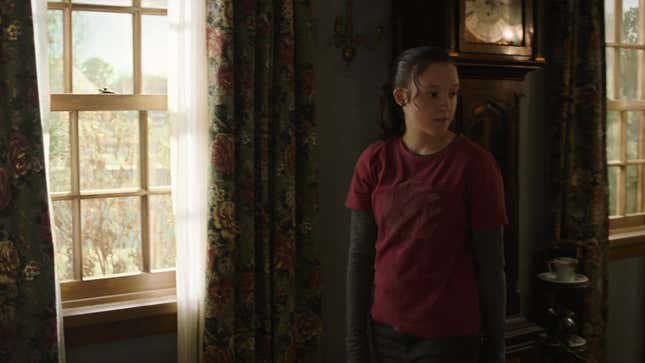
In the TV show, this classic design doesn’t show up until episode three, where she finds it in a box of clothes. Thanks, Bill!
Change: Time period
When it first arrived on PlayStation 3 in 2013, The Last of Us started its fiction in the same year of its release: The outbreak hits in the Fall of 2013 and the main events of the game pick up 20 years later in 2033.
HBO’s TV adaptation changed things up a little bit. Now the pandemic starts in 2003, with Joel meeting Ellie in 2023.
This change wasn’t arbitrary. As Neil Druckmann and Craig Mazin told TechRadar, the time shift was a part of an effort to make the show feel a bit more near to our timeline. On the timeline changes, Craig Mazin said:
It’s a subtle difference. But I have this thing about jumping into the future. I feel like, if I’m watching a show and the year is 2023, and the show takes place in 2043, it’s just a little less real. Even if I’m watching a show in 2023 and it takes place in 2016, it’s a little less real. So I thought it might be interesting to just say, “Hey, look, in this parallel universe, this is happening right now. This is happening this year.”
And while this change might seem like a mostly innocuous shuffling of some numbers, it might have a bit of an impact on specific elements of the story as the show moves on. One notable example is the reference to Facebook in The Last of Us’ prequel DLC: Left Behind. As Facebook launched in 2004, it stands to reason that it doesn’t exist in the show.
Also, though this is unlikely to be within the scope of The Last of Us’ first season (the show has been renewed for a second one), Pearl Jam’s song “Future Days” was featured in the game’s sequel, The Last of Us Part II. As that song was released in 2013, it isn’t likely to exist in the TV universe.
Which, hey, I think I might trade a world-ending apocalypse in exchange for both Facebook not existing and there being less Pearl Jam in the world. Win win.
Same: Fungus among us
The Last of Us has an all-too-real inspiration for its infectious plague. What the show and the game calls “cordyceps” is known in actual nature as ophiocordyceps, a fungus that targets ant colonies in tropical forests. Similar to how The Last of Us’ humans react, the real-world ophiocordyceps takes over ants’ minds, physically warping their bodies and guiding their behavior to serve as nothing more than a vector to spread spores that can infect other ants.
Read More: The Last of Us Makes For Good TV, But It’s a Tough Watch After A Real Pandemic
Fun fact: While ants seem capable of sensing when a member of their brood is infected (removing the infected individuals when necessary), they largely avoid the infection by remaining high up in forest canopies, traveling along a meshwork of constructed trails high above the forest floors to avoid the literal “graveyards” of infected ants below. Keep that in mind next time you play through The Last of Us Part II.
Also, don’t hate onophiocordyceps too much. It too suffers from a hyper parasitic infection known as O. unliateralis. It’s parasites, all the way down.
Change: Spores are out, tendrils are in (and this stuff kills you way faster)
One of the first, and perhaps sharpest, deviations HBO’s The Last of Us takes from the show is how cordyceps spreads in the first place. While a bite from an infected person still transmits the disease, the airborne spores of the game are replaced with tendrils that pour out of an infected body to enter another victim and infect them.
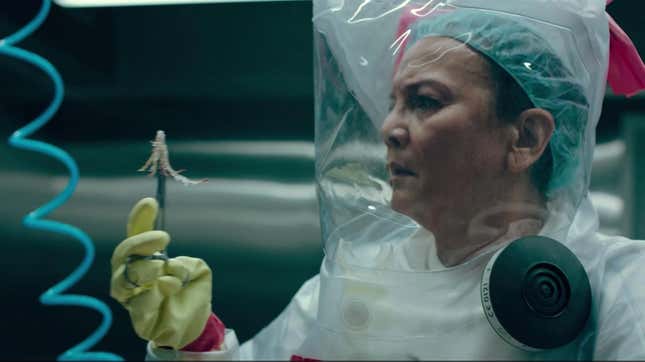
In the game, players often have to navigate areas filled with spores, necessitating a gas mask to avoid infection (though they often seem to take those damn masks off well before it seems safe to). While gas masks aren’t really a game item that players interact with that much, the vulnerabilities of breathing in the infection remain a moment of high tension.
Showrunner Craig Mazin explained that this change came out of a need to build a bit more believability into the show’s world. “If we put spores in the air,” Mazin told Comicbook, “it would be pretty clear that they would spread around everywhere and everybody would have to wear a mask all the time.” It’s a welcome change as we’d have been robbed of Pedro Pascal’s wonderfully expressive face like we were in that other show where he’s escorting another young person with special physiological characteristics. The world is full of original ideas.
Read More: With The Last of Us, Pedro Pascal Becomes The Internet’s Daddy
That said, Mazin hasn’t ruled out spores in the show down the line, saying “I don’t necessarily know if we’re going to see any spores this time around, but to say that our world is devoid of them would not be accurate,” in an interview with Variety.

Another key change of the infection concerns the speed at which someone turns after getting bit. In the game, the revelation of Ellie’s bite and immunity prompts Tess to say “everyone turns within two days.” In the show, as noted from in-world documentation, the time-to-turn varies depending on where someone gets bit. In the show, a best case scenario is a bite on the leg or foot, which seemingly takes 12 to 24 hours. A bite on the torso or other area in the middle of the body sees transformation in two to eight hours, while a bite on the neck, face, or head results in a five to 15-minute grace period.
Fun fact: The in-spore-ation (not sorry) for the cordyceps’ tendrils might just have its roots in the video game. Eagle-eyed fans spotted this in concept art previously, as well as in unused voice lines that mention tendrils. A recent interview with Neil Druckmann and Craig Mazin indicated that the idea indeed came from looking at some conceptual drawings, though it’s not clear if this is the same concept art that was included in the official art book from 2013.
We looked at concept art where there’s this implication of the fungus growing under the skin. What if that was the thing? It’s not so much about the bite, they just need these tendrils to go from one host to another and that’s how the infection spreads.
Same: Runners, clickers, and overgrown areas (oh my)
Though a few infected forms that appear in the game have yet to arrive in the show (we haven’t yet seen a bloater, shambler, or stalker, for example), runners and clickers are in full form, matching their behavior as it appears in the game. Episode two also showed that, much like in the game, specific areas with high concentrations of infected become disastrous dens of death, decay, and fungal overgrowth.
Read More: The Last of Us’ Second Episode Ends In Tragedy
Episode two introduces us to its clickers, who are a mirror image of the shiv-vulnerable beasts we’re used to in video game form. Like in the game, Joel indicates to Ellie that these creatures can’t see, but that they instead have razor-sharp hearing that they likely use to echolocate.
Fun Fact: The show goes another step further in matching up its clickers to the game, using the same voice actors who dedicated their talents to click, scream, and make all manner of weird sounds in the games.
Change: The infected appear to be connected
It’s not entirely clear whether or not this doesn’t exist in the game’s fiction (though it would explain how some of these bastards seem to know where I am entirely too fast), but as Tess tells Ellie in the second episode, the infected appear to be networked, sharing some kind of uniform consciousness and sensory input: “You step on a patch of cordyceps in one place, and you can wake a dozen infected somewhere else. Now they know where you are, now they come.”
This is seen in real time in episode two, where the disturbance of recently infected humans quickly leads a horde to descend on Joel, Ellie, and Tess—the last of whom’s death is depicted on screen in a frankly condemnable way. Joining the ranks of Game of Thrones’ David Friedman and D. B. Weiss, Neil Druckmann and Craig Mazin have submitted their contribution to the time-honored masculine tradition of depicting awfully-coded violence against women on screen because it’s so “triggering” and “violative.” Good job, boys. How ever will you shock us next?
Read More: HBO’s The Last of Us Does Tess Dirty
Same: The infection spread via contaminated crops
The Last of Us as a video game isn’t terribly concerned with exploring too many specifics of pre-outbreak society, or even where the infection came from necessarily. But as seen in a newspaper article Sarah can briefly peruse in the first game’s prologue, the lead up to the outbreak involves “the Food and Drug Administration’s investigation of crops potentially contaminated mold.”
The opening of episode two reveals that, in fact, some of the early cases of infection did in fact breakout in a flour factory. A later episode sees a character talking about cases of contaminated food stuffs, mainly flour (which we’ll talk about in a bit).
Change: A narrative patient zero
Though the show stops just shy of saying exactly who and where patient zero is, it opens up episode two by taking us to a new place where the infection is just about to hit a dangerous point of no return: Jakarta, which Sarah informed us was the capital of Indonesia just one episode ago.
Read More: The Last of Us Episode One Recap: Taking A Ride
Diverging from the in-game newspaper’s mention of South America, the show decided it would be appropriate, for whatever reason, to suggest that the outbreak began in an Asian country first.
Change: Joel didn’t get infected because….the Atkins diet?
So, in both the show and the game, we know that contaminated crops play a significant role in the spread of the infection. But if flour, a pretty common ingredient in most food, was one of the key vectors of transmission, how did Joel avoid it?
While we know that Sarah was unable to make pancakes given that they were out of flour (and that she didn’t eat her neighbor’s contaminated cookies because gross, raisins), surely flour would’ve existed somewhere else for Joel to have come in contact with? Well, in episode one, Joel tells his neighbor he’s on the Atkins diet. While I first assumed this was a simple nod to a very silly keto-adjacent diet that was popular in the 2000s, as Esquire observed, fans are speculating that Joel’s aversion to carbs is likely what kept him safe while the world fell apart.
So there ya go: Weird, probably-unhealthy diets might make a difference after all. Let’s just hope the show doesn’t decide to haunt us with more forgettable elements of early ‘00s American culture.